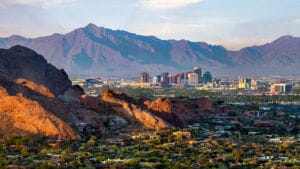Location matters when it comes to the chances that a child born into poverty in Arizona will move up the economic ladder during his lifetime, a recent study shows.
The study, by researchers at Harvard and the University of California, Berkley, found that a child born into a Phoenix family in the bottom fifth of income has a 7.8 percent chance of ever rising to the top fifth. Those are about average odds for the nation, one of the report’s authors said.
But near some of Arizona’s Indian reservations, a child born into poverty has just a 4.8 percent chance of rising to the top, the lowest rate in the Southwest.
Chances of success varied significantly around Arizona, from the best odds of 10.8 percent in Yuma to the worst at 4.8 percent in northwestern Arizona, which part of a “commuting zone” around Gallup, N.M.
“There are very high concentrations of poverty among the Native American tribal members because of lack of access to opportunities,” said Teresa Brice, executive director for the Phoenix office of Local Initiatives Support Coalition.
For “people who want to stay in their indigenous lands, it’s very difficult for them to get to where the job centers are,” Brice said.
The study, by the Equality of Opportunity Project, divided the U.S. into 741 commuting zones, each named after the largest city in the zone. The researchers looked at anonymous earnings records over time to determine the likelihood that someone could move from one income level to another.
People making $25,000 or less were considered to be in the bottom fifth of income while those making more than $100,000 were put in the top fifth. For purposes of the study, then, a child who had one parent making $25,000 would have to earn $100,000 or more as an adult to be counted as successfully making the bottom-to-top transition.
Nathaniel Hendren, assistant professor of economics at Harvard and one of the report’s authors, said that Phoenix’s odds were about in the middle for the country. By comparison, Atlanta had one of the nation’s lowest mobility rates at 4 percent, while San Francisco had one of the best rates at 11.2 percent.
Hendren could not explain why Yuma, which regularly posts some of the nation’s highest unemployment rates, had the best chances of upward mobility in Arizona. But he said there are several factors that correlated with mobility in markets around the nation.
Hendren said that regions with low levels of segregation, better school quality and higher civic or religious engagement tended to have higher rates of upward mobility. He also said that children in two-parent households tended to do better as well.
While Hendren pegged Phoenix’s upward mobility chances as about average, several local experts painted a different picture on the ground.
Brice said a key factor in economic mobility is actual mobility – the ability to get to and from work and other supports. In that sense, she said Phoenix and Atlanta are somewhat similar in terms of sprawl and transportation options.
Brice said that those two factors have made it difficult for people who can’t afford cars to find and maintain jobs.
“Phoenix and Atlanta were very similar five years ago in the amount of sprawl that we were doing,” she said. “At the height of the housing bubble, Phoenix was eating up an acre of desert an hour to development” without offering many transit options.
That isolation is one of the reasons behind low social mobility numbers near Indian reservations, Brice said.
Cynthia Zwick, executive director for Arizona Community Action Association, agreed that transportation is a problem. But she also pointed to relatively low funding of schools in Arizona and the state’s low minimum wage.
“We talk with folks every day who are working two, three jobs, but at minimum wage,” Zwick said. “It’s very difficult, actually impossible really, to sustain yourself or family on that level of income.”
Brice noted that Phoenix’s light-rail system has helped some people keep jobs without a car, but said more work needs to be done. She hopes that cities will focus more on adding to “existing infrastructure” than on building farther out in the future.
“We have to look at what is already in place, how can we fix it first rather … than having to continually build new infrastructure further and further away in order to accommodate development,” she said.




